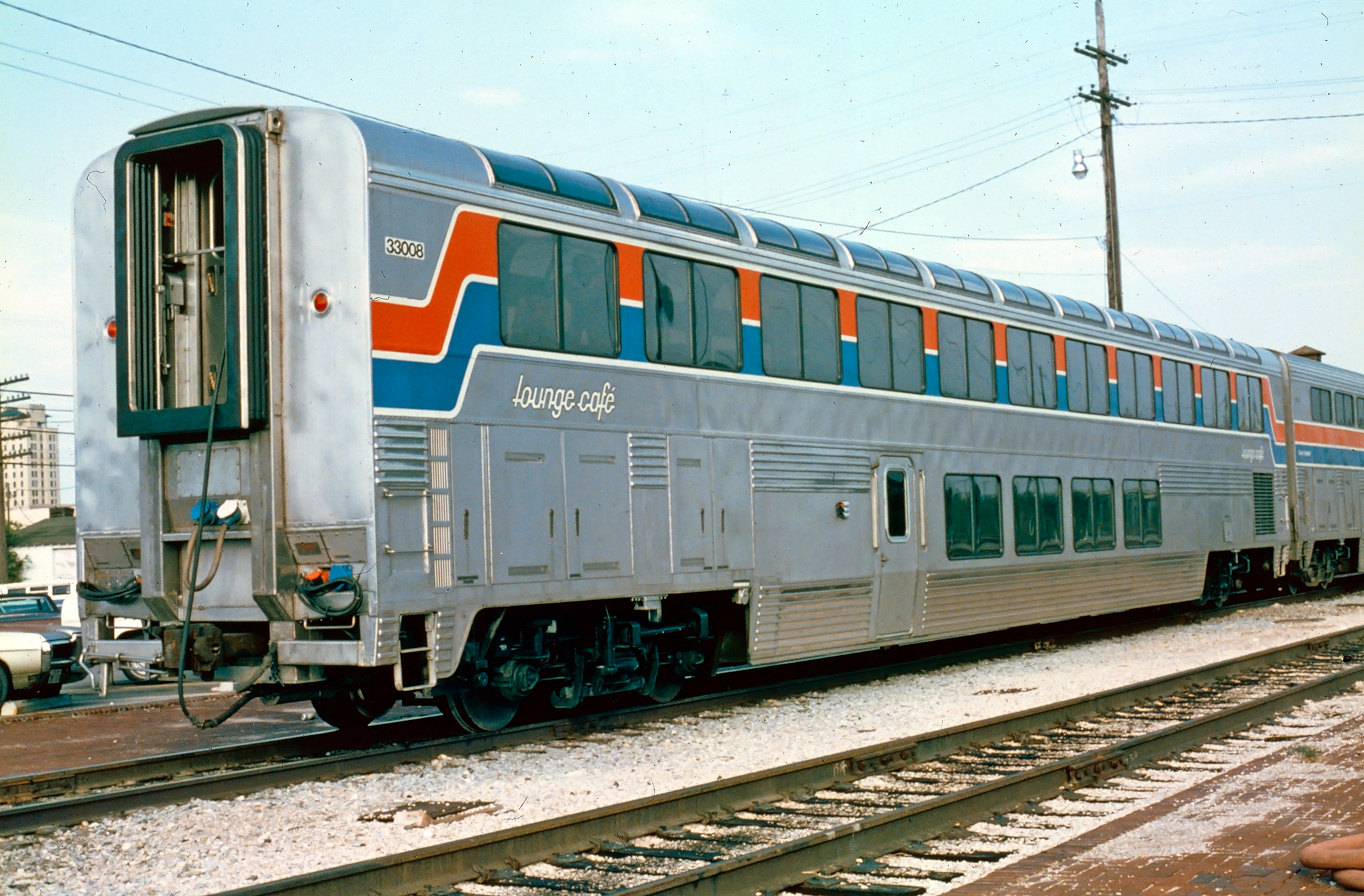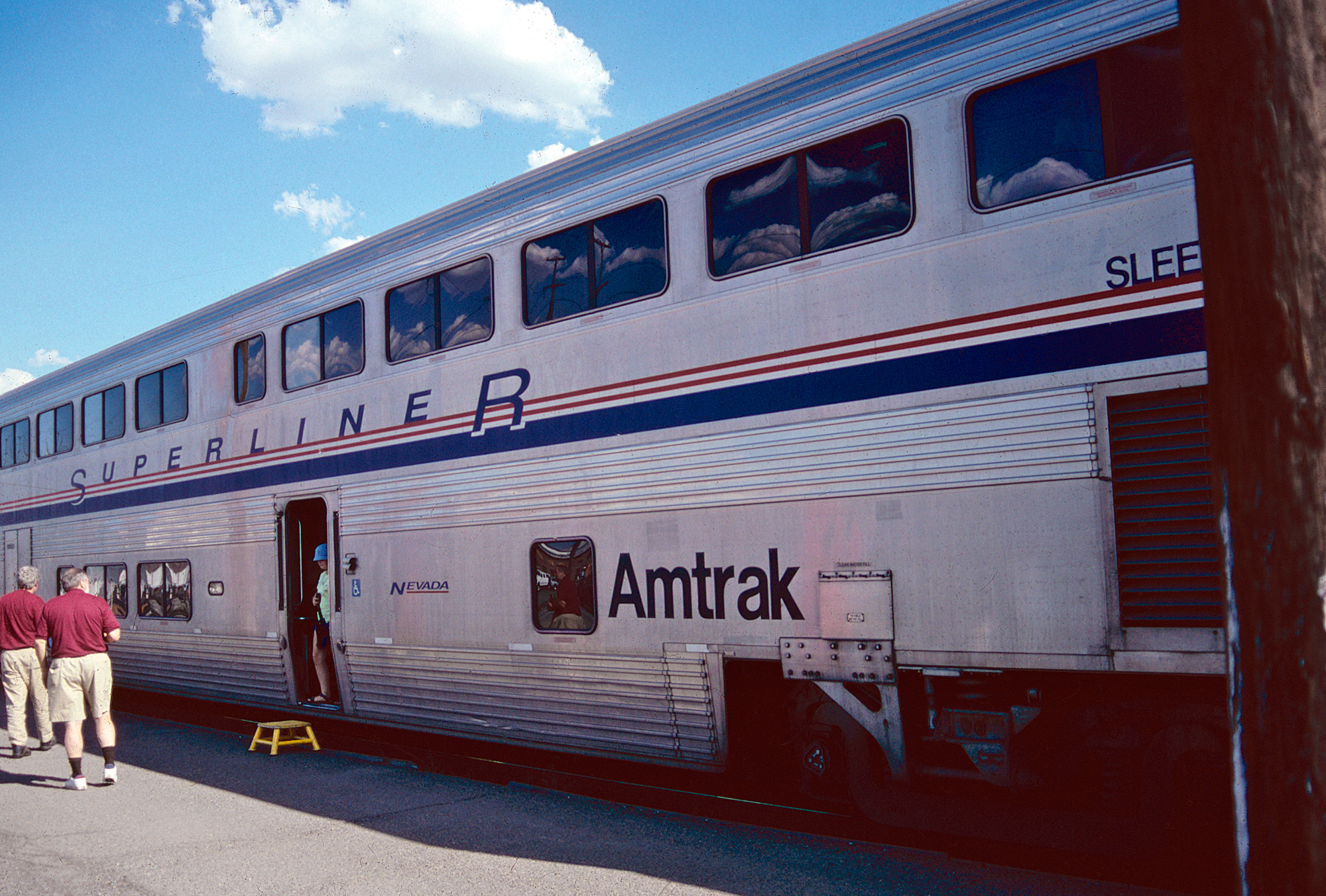- Home ›
- Amtrak ›
- Superliners
The Superliners (Railcar): Providing Unmatched Comfort
Last revised: September 6, 2024
By: Adam Burns
The Superliner is a type of bilevel intercity passenger car used by Amtrak, the nation's passenger rail provider. Since it debuted in 1975 it has become the carrier's primary long-distance car, offered in a variety of accommodations from coach to sleeper.
The design was based on the Budd Hi-Level cars, famously used by the Santa Fe on its El Capitan trains beginning the 1950s. Pullman-Standard built 284 cars, known as Superliner I, from 1975 to 1981; Bombardier Transportation built 195, known as Superliner II, from 1991 to 1996.
In total, 479 cars were manufactured during a 21-year production run. The Superliner I cars are notable as the last passenger cars built by Pullman. Over the years, Amtrak has upgraded the cars, including as recently as the late 2010s.
Photos
 An Amtrak Superliner I "Sightseer" lounge café, #33008, is seen here in 1984. The car was part of a group of 25 manufactured by Pullman-Standard in 1981 (33000-330024), along with 25 more from Bombardier (33025–33049, dubbed "Superliner II's). Mike Bledsoe photo. American-Rails.com collection.
An Amtrak Superliner I "Sightseer" lounge café, #33008, is seen here in 1984. The car was part of a group of 25 manufactured by Pullman-Standard in 1981 (33000-330024), along with 25 more from Bombardier (33025–33049, dubbed "Superliner II's). Mike Bledsoe photo. American-Rails.com collection.History
The history of the Superliner railcars by Amtrak takes us back to the mid-1970s, the time when the initial Superliner I cars were produced.
The Pullman-Standard, the manufacturer responsible for creating these railcars, manufactured 284 Superliner I cars from 1975 to 1981. The cars were built with exact dimensions of 85 feet in length, 10.5 feet in width, and an impressive 16.5 feet in height, contributing to their distinctive multi-level design.
These first-generation Superliner cars comprised of several car types including transition sleepers, sleeping cars, parlor cars, lounge cars, dining cars, and even sightseer lounge cars.
Later, the introduction of the Superliner II emerged in the early 1990s. Built by the Canadian company Bombardier Transportation, the production of 130 Superliner II cars commenced in 1991 and went on until 1994.
These cars, similar to their predecessors, measured 85 feet in length, 10.5 feet in width, and maintained a towering height of 16.5 feet. Offering a diverse array of new car types, these included sleepers, coaches, lounge cars, and sightseer lounge cars.
Hi-Levels
Interestingly, the Superliners were inspired by the Santa Fe railway's Hi-Level bilevel cars which were substantially popular back in the 1950s and 60s. The Hi-Level cars were principally used for "El Capitan" service, a distance stretch that ran from Chicago to Los Angeles.
Overview
| Builder | Class | Type | Quantity | Original Road Numbers |
|---|---|---|---|---|
| Pullman-Standard | Superliner I | Coach-baggage | 48 | 31000–31047 |
| Pullman-Standard | Superliner I | Sleeper | 70 | 32000–32069 |
| Bombardier | Superliner II | Sleeper | 49 | 32070–32118 |
| Bombardier | Superliner II | Deluxe sleeper | 6 | 32500–32505 |
| Pullman-Standard | Superliner I | Sightseer lounge | 25 | 33000–33024 |
| Bombardier | Superliner II | Sightseer lounge | 25 | 33025–33049 |
| Pullman-Standard | Superliner I | Coach | 102 | 34000–34101 |
| Bombardier | Superliner II | Coach | 38 | 34102–34139 |
| Pullman-Standard | Superliner I | Diner | 39 | 38000–38038 |
| Bombardier | Superliner II | Diner | 30 | 38039–38068 |
| Bombardier | Superliner II | Transition sleeper | 47 | 39000–39046 |
Initially entering service on February 26, 1979, Superliner I cars brought a new era to Amtrak’s cross-country rail service. Fast-forward to 1993 and the Superliner II cars were drafted into service, adding scale and improved facilities to the already established Superliner travel experience.
The Superliners have been widely recognized for the variety of accommodations these railcars offer its passengers. Including different car types from the standard Coach cars to Deluxe Bedrooms, the Superliner manages to cater to the varied needs and requirements of its passengers efficiently.
 One of Amtrak's popular bilevel "Superliner" sleepers at Reno, Nevada in June, 2000. This car was part of the original Superliner I fleet (284 cars) manufactured by Pullman-Standard between 1975-1981 and based from the Santa Fe's Hi-Level cars (Budd) used on its "El Capitan." Bombardier Transportation would later build another 195 "Superliner II" cars between 1991-1996. American-Rails.com collection.
One of Amtrak's popular bilevel "Superliner" sleepers at Reno, Nevada in June, 2000. This car was part of the original Superliner I fleet (284 cars) manufactured by Pullman-Standard between 1975-1981 and based from the Santa Fe's Hi-Level cars (Budd) used on its "El Capitan." Bombardier Transportation would later build another 195 "Superliner II" cars between 1991-1996. American-Rails.com collection.The Superliner I cars are known to weigh approximately 159,500 pounds, whereas the later Superliner II railcars tip the scales at approximately 162,400 pounds, offering a comfortable and stable ride to the passengers onboard.
Over time, as per the need for improvement and customer comfort, Superliners have gone through several rebuilds. Notably, in 1999, under the Capstone program, the Superliner I fleet underwent refurbishment to offer upgraded amenities and decor, closer to that found in their successor, the Superliner IIs.
Amtrak currently operates several of its cross-country and long-distance trains with Superliner cars. These include the California Zephyr, Southwest Chief, Texas Eagle, Empire Builder, Coast Starlight, and Sunset Limited.
When it comes to accommodations, the Superliner sleeping cars provide a variety of options. Family Bedrooms offer suite-style accommodations that can house two adults and two children. A Deluxe Bedroom comes equipped with private shower and bathroom facilities and can accommodate up to two adults. The Roomettes, on the other hand, are ideal for solo travelers or couples.
Superliner Sightseer lounge cars offer panoramic windows on the upper levels, allowing travelers to soak in the scenic views along their journey. The lower level features a cafe, perfect for casual dining or grabbing a quick snack.
Superliner coach cars are designed to offer a comfortable journey to all passengers. These cars feature seats that can recline to 45 degrees, ample legroom, and individual control reading lights. Overhead racks are made available for luggage while large picture windows ensure passengers don’t miss the scenic route.
Specifications
| Weight | 151,235 - 174,000 lbs |
| Length | 85' 0" |
| Width | 10' 2" |
| Height | 16' 2" |
| Platform Height | 0' 8" |
| Entry | Steps |
| Top Speed | 100 mph |
| Power Supply | 480 V AC 60 Hz |
| Truck Type | Waggon Union MD-76 (Superliner I), GSI-G70 (Superliner II) |
| Manufacturers | Pullman-Standard (Superliner I), Bombardier (Superliner II) |
| Construction Dates | 1975–1981 (Superliner I), 1991–1996 (Superliner II) |
| Entered Service | February 26, 1979 |
There are derivatives of the Superliner cars used in certain Amtrak trains. For instance, the Pacific Parlour Cars, specific to the Coast Starlight route, were rebuilt from Superliner I lounge cars and used from 1995 till their retirement in 2018.
The overall design of the Superliner cars features a distinctive bilevel design inspired by the Hi-Level cars. The lower level makes room for entrances, some seating, and equipment, while the upper level dominates passenger seating and room accommodations.
For the purpose of suspension and smooth running, the Superliner cars use a type of truck known as the GSI 70 ton, which was designed by General Steel Castings.
Amtrak is reportedly planning a replacement for the Superliner cars as part of its long-distance fleet refurbishment strategy. For now, the exact models and types that would replace these remain under fold.
Conclusion
Superliner cars, with their multilevel design, can accommodate a large number of passengers. While the exact capacity depends on the specific car type, typically a Superliner Coach car can seat over 60 passengers, while a Lounge car can comfortably accommodate approximately 44 individuals.
Meanwhile, a Superliner sleeping car can house up to 44 passengers across various room accommodations. Amtrak’s Superliners are true testament to the historic and enduring legacy of America's rail transportation; they offer a unique blend of comfort, convenience, and utter fascination for the rail enthusiasts.
Sources
- Dorin, Patrick C. Santa Fe Passenger Trains In California: From The 1940s Thru Amtrak And More. Forest: TLC Publishing, Inc., 2006.
- Glischinski, Steve. Santa Fe Railway. St. Paul: Voyageur Press, 2008.
- Solomon, Brian. Amtrak. St. Paul: MBI Publishing Company, 2004.
- Tyre, Peg (Editorial Director). Amtrak: An American Story. Washington: National Railroad Passenger Corporation, 2011.
Recent Articles
-
New Mexico Railroad Museums: A Complete Guide
Apr 23, 25 02:25 PM
The enchanting state of New Mexico, known for its vivid landscapes and rich cultural heritage, is home to a number of fascinating railroad museums. -
New Hampshire Railroad Museums: A Complete Guide
Apr 23, 25 02:11 PM
New Hampshire, known for its breathtaking landscapes, historic towns, and vibrant culture, also boasts a rich railroad history that has been meticulously preserved and celebrated across various museum… -
Minnesota Railroad Museums: A Complete Guide
Apr 22, 25 12:17 PM
The state of Minnesota has always played an important role with the railroad industry, from major cities to agriculture. Today, several museums can be found throughout the state.